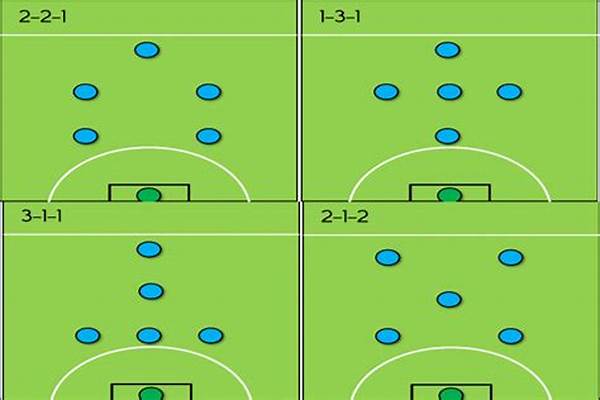Best Formations For Amateur Soccer Teams

Imagine your weekend soccer match: the sun is shining, the grass is green, and you are just moments away from leading your amateur soccer team to victory. As an amateur manager, crafting your squad’s winning edge doesn’t just rely on skill and enthusiasm; choosing the right formation can be your secret weapon. Let’s face it, soccer formations are more than just numbers on paper; they’re the blueprint to your team’s success.
Read More : Simple Morning Exercise Tips That Keep You Fresh Every Day
However, diving into the world of soccer tactics can be a daunting task. With buzzwords flying around and numbers that look like mathematical equations, it’s easy to feel overwhelmed. But fear not! This blog uncovers the secrets behind the most effective formations for amateur soccer teams, helping you make strategic decisions that could make Pele proud. Oh, and don’t worry—we’re sprinkling a bit of humor along the way to make this journey not only informative but also fun!
Understanding Soccer Formations for Amateurs
So, what exactly are the “best formations for amateur soccer teams”? First, let’s break it down—formations are strategic arrangements of players on the field, tailored to optimize strengths and minimize weaknesses. Every formation has a unique selling point that appeals to different styles of play, so it’s essential to understand the core characteristics of each one.
The Classic and Ever-Popular 4-4-2
Starting with the classic 4-4-2 formation, this setup is like that friend who’s always reliable—a balanced formation that offers a solid defensive foundation while still enabling attacking opportunities. With four defenders, four midfielders, and two forwards, amateur teams often find comfort in its simplicity and effectiveness. This formation caters to a variety of playing styles, promoting teamwork and spreading responsibilities equally among the players. Here’s a fun trick—next time your team is lagging in the first half, suggest a switch to the dependable 4-4-2 and see your fortunes possibly turn around!
Going Modern with the 4-3-3
For those who prefer a dash of modern football flair, the 4-3-3 formation introduces a fresh dynamic emphasizing attacking prowess. Featuring four defenders, three creative midfielders, and three dynamic forwards, it’s a formation designed for teams ready to take the initiative. When employing the 4-3-3, your wing players become crucial, offering width and creative possibilities, making every attack a potential highlight for the season. Just imagine Elvis Presley strumming an electric guitar—exciting, daring, and bound to leave an impression!
Best Formations for Amateur Soccer Teams: In-Depth Analysis
It’s time to dive deeper into the nerdy aspects of these top formations. Which one truly suits your team like a glove? Let’s embark on this educational adventure!
The Robust 3-5-2 Formation
If your amateur team prides itself on athleticism and adaptability, the 3-5-2 formation might just be your metaphorical golden goose. With three solid defenders forming a sturdy backbone, and five midfielders offering both defensive cover and attacking support, this formation turns complexity into mastery. “Best formations for amateur soccer teams,” you wonder? Well, the 3-5-2 is the Swiss Army knife—versatile, ready for any challenge, and keeping opponents on their toes.
Defensive Resilience and Offensive Flexibility
The beauty of the 3-5-2 primarily lies in its defensive fortitude while still offering offensive flexibility. This formation demands full-backs with lungs of steel, as they swap between assisting the defense and bolstering the attack. Implementing this can feel like you’re directing an elaborate heist—albeit with shin pads and jerseys!
Read More : Sports Highlights: The Most Exciting Big Football Matches In September 2025
Importance of Player Roles and Communication
An amateur team’s journey with any given formation ultimately provides insights into player roles and communication. Every role becomes paramount in turning the written tactics into executed brilliance on the field. By prioritizing communication, formations such as the 3-5-2 or 4-4-2 can transform into vehicles driving your team to success.
Key Points on Formations for Amateur Teams
Selecting the best formations for amateur soccer teams might seem like rocket science, but worry not! Here’s a distilled version to help navigate the nuances quicker than you can say ‘pass the ball.’
Concluding Insights on Formations
Selecting “best formations for amateur soccer teams” boils down to understanding soccer’s beautiful dance of shape and strategy. The perfect formation must resonate with your team’s identity, amplifying strengths and offering avenues for continuous improvement.
Donning your coach hat, recognize that soccer formations are more than numerical melody—they enable stories of triumph against larger teams, unexpected dribbles past defenses, and that sweet, palpable camaraderie moments after a goal. Let your chosen formation become the canvas on which your squad’s epic performs. No formal training needed—just an eye for strategy and a passion for improvement. Only then, infused with humor, logic, and emotion, is your team ready to conquer and entertain!
Now, take charge, share this wisdom with your team, and craft tales of glorious soccer nights. Because after all, the heart of the “best formations for amateur soccer teams” lies within the smiles of teammates and the cheers from the sidelines.



